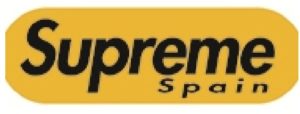15/02/2019
Supreme, established in New York in the mid-90s, is a well-known multinational streetwear brand that has customers eagerly waiting for its latest drops of clothing, which are available in limited quantities and for a limited time. Supreme is widely recognised, in at least the US and Europe, by its famous red logo with white text as shown below.

This is not to be confused with Supreme Italia, an imitation brand that is presently causing a headache for Supreme. Here’s how…
Trade mark protection operates on a territorial basis. This means that when a company applies for a trade mark in a certain territory, it is granted protection for that trade mark only in that particular territory. For example a US registration covers the USA, an EUTM covers the European Union (as it grows, or shrinks). There is no one worldwide trade mark registration.
Although Supreme obtained trade mark protection in some of the main countries of interest to the business, it did not obtain trade mark protection in others. This left the window open for Supreme Italia (owned by International Brand Firm Ltd) to swoop in and obtain some trade mark protection of their own, and they are now using those to try and block Supreme’s EU application. These are the marks Supreme Italia have registered in Italy and Spain.


The Italian’s marks are also confusing consumers, who are thinking that the Supreme Italia trade mark used for bags, clothing and retailing is, or is connected with, Supreme. Indeed, many would assume that this is a brand extension for Supreme and that they simply launched in Italy or Spain.
It has been reported that even the electronics giant Samsung were confused. After Supreme Italia announced that they would be opening stores in China, Samsung announced a collaboration with the brand at the Galaxy A8 launch event in China back in December last year, stating that they would be selling exclusive products with the store. Samsung soon backed out when they realised Supreme Italia was not the famous streetwear company.
Some might question how is it that an imitation brand has been able to obtain trade mark protection for a mark that isn’t even of their own creation. Not all trade mark offices block applications because there is something already on the register, or because the examiner is aware that the brand is famous already and raises awkward questions.
When Supreme filed to obtain pan-EU protection for their famous red and white mark, they were opposed by the owners of Supreme Italia, International Brand Firm Ltd. Supreme Italia claimed earlier registrations in Italy and Spain, for the marks shown above. Supreme have counter-filed invalidation actions against the Italian and Spanish trade marks on the grounds that they were filed in bad faith. Supreme were not able to point to even earlier registrations. The EU opposition proceedings have now been suspended pending the outcome of the invalidation actions.
To add fuel to the fire, an unknown third party filed observations arguing that Supreme’s EU trade mark application for SUPREME should not have been accepted for publication because on the face of it, the word Supreme lacks distinctiveness and is descriptive for the highest quality goods or services offered.
Whilst it is tempting to put off the expense of filing trade mark applications, securing registered rights generally puts a famous brand in a stronger position than having to argue on reputation alone. The other action many parties take is to subscribe to a trade mark watch. This pulls out potentially troubling applications when there is still a chance to oppose, aiming to prevent the imitators from gaining their own registrations.
This article is for general information only. Its content is not a statement of the law on any subject and does not constitute advice. Please contact Reddie & Grose LLP for advice before taking any action in reliance on it.

